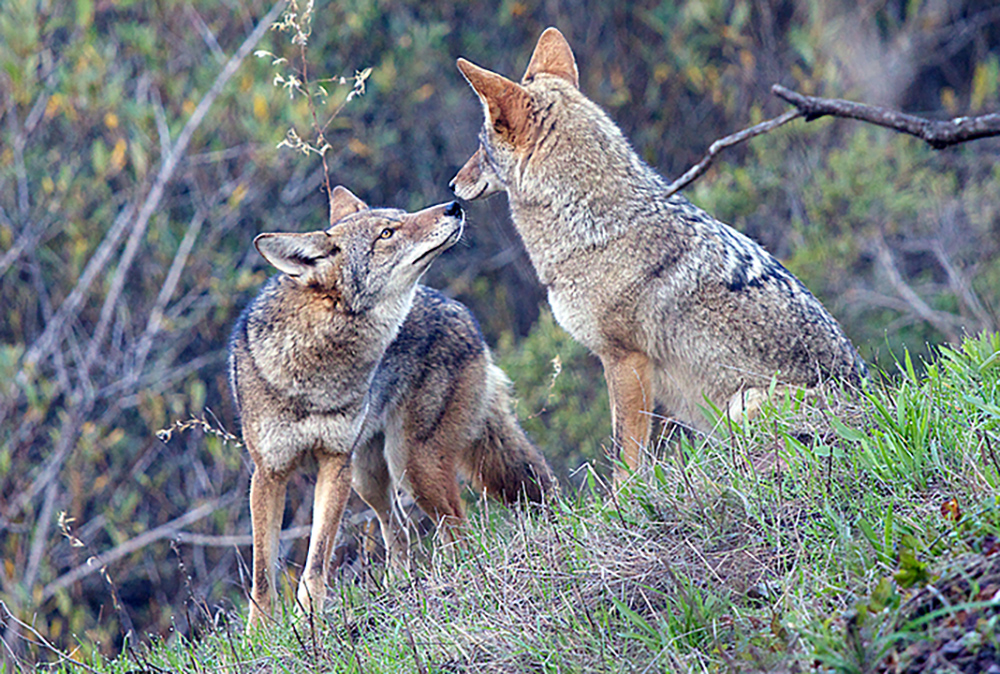By Bill Barlow
John Rosenberg of Atlantic City knew there were coyotes in the woods of Atlantic County.
An avid deer hunter, he had heard their yips and howls, including once in response to a nearby siren, and he had even seen them in the past. Still, as his day came to a close a little past sunset, he was surprised to see two of the animals walking under his tree stand.
They looked almost like they could be somebody’s pair of German shepherds, with bushy tails and thick coats, but he had no doubt they were coyotes. This was muzzle-loader season, he said, about two years ago.
“They were big,” he said. “It was kind of a little intimidating, especially with the two of them together.”

Coyote attacks on humans are extremely rare. Still, with a long walk back to the car ahead of him, Rosenberg was perhaps a little more attentive than usual to the sounds around him as the woods got dark.
Hunters get used to seeing deer, he said, and plenty of other animals like hawks, skunks or foxes. Sometimes growing to more than 50 pounds – and often looking bigger with their shaggy coats – coyotes are a different kind of sighting.
They are also becoming increasingly common. The animals have been reported in almost 400 municipalities in all 21 counties in New Jersey, with a significant increase since 1980. A graphic representation posted to the website of the New Jersey Department of Environmental Protection’s website shows the coyote range in red. In 1960, there are just a few spots on the mostly empty map. Most of them are in the densely wooded far northwest of the state, with a patch at the southernmost tip of Cape May.
Each decade, those numbers increase, until almost the entire state shows red by 2012. At one count –likely incomplete for such a secretive animal – there were an estimated 3,000 coyotes throughout New Jersey. There is every reason to believe the population continues to increase, but Andrew Burnett, a principal wildlife biologist with the Division of Fish and Wildlife, said the number of reported sightings has dropped.
“We used to get a lot more reports than we do,” Burnett said in a recent interview. “I think they’ve become common to the point that people don’t give them a second thought or think that they need to be reported.”
He does get reports from hunters, who are required to report when they shoot a coyote, and a couple of dozen of the animals are struck by cars each year.
Burnett, whose specialty is upland game and furbearer research, lives in Galloway.
“I’ve only seen a handful of live coyotes,” he said. One was crossing the Garden State Parkway by the Atlantic City reservoir. It was moving fast, he said.
“They’re very wary,” he said. “They’re a difficult animal to harvest if you’re a hunter. It’s a little bit easier if you’re a trapper.”
There’s an old saying about wild animals: That they are more afraid of you than you are of them. For some, like grizzly bears and sharks, that’s probably nonsense. But for coyotes, it seems true.
According to DEP Spokesman Larry Hajna, there have been instances of attacks from rabid animals.
“A healthy coyote attacking a person is exceedingly rare,” said Burnett.
But exceedingly rare is not never.
The only recorded attack in New Jersey was in Boonton Township in 1999, in which a woman was walking several dogs. A coyote attacked the dogs, and the woman fell and broke her leg. According to reports, the coyote bit her arm and did not flee until an onlooker hit it with a stick.
More common are attacks on cats, dogs and livestock. Outdoor cats are the most likely to be attacked. In 2005, a coyote killed a pet poodle in Lower Township. The animals also prey on sheep and lambs, particularly in the spring.
In Upper Township, Bill Simmerman said coyotes are all around in New Jersey. He’s the owner of Misty Meadows Farm, a sheep dairy in the Petersburg section of Upper Township. He said the sheep know when there are coyotes around.
“We have them here occasionally. I have a unique way of battling them,” he said. Rather than shoot or trap the animals, he set up a high tensile electric fence around the sheep. It does not take long for the coyotes to decide they’d rather stay away.
“It’s just like training a dog with a shock collar,” Simmerman said.
For years, there was a persistent story that the state introduced coyotes to control the deer population. That’s a common assumption south of the Cape May Canal, where there has been a breeding population of coyotes in the preserved land for decades, even when the rest of the Jersey coyotes were on the far side of the New Jersey Turnpike.
The DEP has never introduced the animals. But Burnett suggested it is possible they were introduced just the same. He found an article from 1949 about a zoo that gave two coyote pups to a New Jersey couple. In a recent interview, he raised the possibility that some of the coyotes in southern New Jersey descended from those pups.
Coyotes are indigenous to the American West. In Colonial times, Burnett said, New Jersey had red wolves and gray wolves, but no coyotes. The accepted theory for the spread of coyotes is that they moved east across Canada and crossed the St. Lawrence River.
“At least some of them came in the back of somebody’s station wagon,” Burnett said.
The animals remain rare on the barrier islands. Hajna joked that they wanted to avoid beach fees.
The first wild coyote reported in New Jersey was in 1939, near Lambertville in Hunterdon County. Reports came sporadically after that. The state still gets reports. Many of the callers are surprised to learn that coyotes live in the nation’s most populated state. Some want them removed, Burnett said.
“They say, ‘I want him out.’ Well, he’s not doing anything,” he said. “Some people see wildlife and they want it gone.”
The state does have tips for living with coyotes, including keeping garbage in tightly closed containers and bringing pet cats and dogs inside at night. Putting out cat food can attract coyotes and other critters, which puts the cat and other pets in danger.
“If coyotes are present, make sure they know they’re not welcome. Make loud noises, blast a canned air siren, throw rocks, or spray them with a garden hose,” reads the recommendations on the DEP website.
Tips for Protecting Your Pets from Coyotes
Coyotes have been spotted throughout the area in recent months. Although they normally do not pose any danger to humans, they can be a danger to small animals. Small dogs and cats are especially vulnerable if left outdoors alone.
NEVER leave your pet unattended: Keep an eye on your pet when you open the back door to let him out and do not let him stray too far away from you. Whenever possible, take your dog out on a leash. You should use a 6-foot leash, not a retractable leash, as they provide little to no control if your pet encounters a coyote. Also avoid walking your dog during twilight hours as coyotes are more active at night, so it’s best to keep an extra eye on your pet when you let him out after the sun goes down. Carry a headlamp or flashlight when walking your dog at night.
Cover and secure all garbage cans: Garbage cans should be secured with wildlife proof lids. All cans should be sprayed with ammonia inside and out each time you open them to remove any food smell which attracts wildlife.
Do not feed wildlife: One of the biggest reasons that coyotes are coming into neighborhoods is the attraction of food. If you feed feral cats, the food should be removed 30 minutes after each feeding to discourage wildlife from sharing the food.
Do not feed your pet outside: As food can be a big attractor of coyotes, giving your pet his dinner indoors is always a good idea. If you feel you must feed your pet outside, feed midday at a set time and pick up leftovers immediately.
Be extra mindful during coyote breeding season: April is when the coyotes are going to have their young and April through August is when they are going to be more protective of their young. Walk a dog on leash and be cognizant of coyotes in the area.
Remove any kind of attractants around the exterior of you house: Feeding wildlife and birds can attract coyotes to your yard. Attractants for coyotes include compost, dirty grills, and birdseed. Birdseed, for instance, can attract rodents and, therefore, attract coyotes. Fallen fruit should also be cleaned up, as coyotes consume large amounts of fruit during certain points in the year.
Make your yard a less attractive habitat: Keep trees and shrubbery trimmed to reduce cover, which makes great hiding places for coyotes. You can install coyote-proof fences (these are typically quite high) or use motion-triggered deterrents like light or sprinkler systems. Fences should be at least 6-foot high and buried at least 6 inches underground or fitted with a mesh apron on the outside of the fence extending 12 inches out from the bottom of the fence and secured with landscape.












